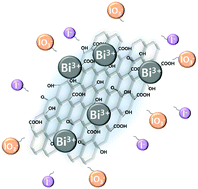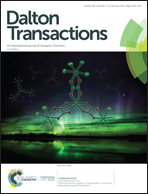Development of bismuth-functionalized graphene oxide to remove radioactive iodine
Abstract
Bismuth-functionalized graphene oxide (Bi-GO) was successfully synthesized and showed both high iodide and iodate removal efficiencies from radioactive wastewater. Batch experiments for kinetic and selectivity tests were performed, respectively. Additional SEM, XRD, FT-IR, and XPS analyses were performed for characterization of a sorbent and bismuth on the GO surface and this confirmed that bismuth on the GO surface reacted with iodine species by surface complexation (or precipitation). Dominant surface species are BiOI and Bi(IO3)3 for iodide and iodate removal, respectively. After the selectivity test using a KCl background solution with varying concentrations, Bi-GO still showed higher removal efficiencies (≥95%) for both iodide and iodate than the commercial silver-exchanged zeolite (≥95% for iodide and ≤25% for iodate). Our study suggests the potential application of Bi on graphene-based materials for selective removal of both iodide and iodate from radioactive wastewater.



 Please wait while we load your content...
Please wait while we load your content...